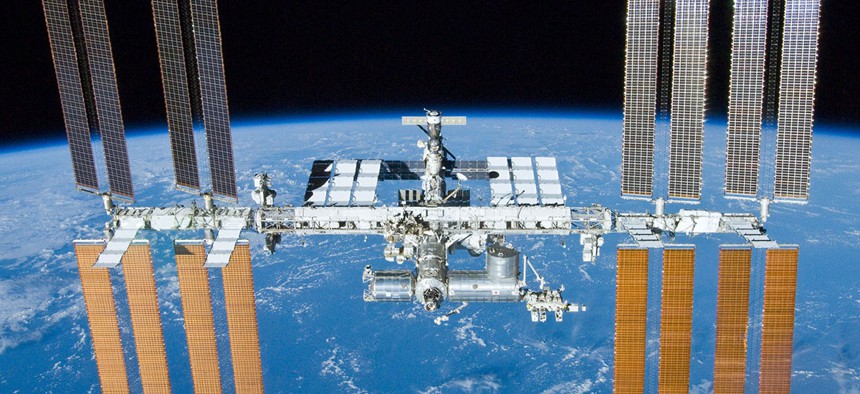The Growing Risk of War in Space

NASA
The prospect of weaponized satellites launching a Pearl Harbor-style attack in orbit is more probable than many people realize.
In "Ghost Fleet," a 2015 novel by security theorists Peter Singer and August Cole, the next world war begins in space.
Aboard an apparently civilian space station called the Tiangong, or “Heavenly Palace,” Chinese astronauts—taikonauts—maneuver a chemical oxygen iodine laser into place. They aim their clandestine electromagnetic weapon at its first target, a U.S. Air Force communications satellite that helps to coordinate forces in the Pacific theater far below. The laser “fired a burst of energy that, if it were visible light instead of infrared, would have been a hundred thousand times brighter than the sun.” The beam melts through the external hull of the U.S. satellite and shuts down its sensitive inner circuitry.
From there, the taikonauts work their way through a long checklist of strategic U.S. space assets, disabling the nation’s military capabilities from above. It is a Pearl Harbor above the atmosphere, an invisible first strike.
“The emptiness of outer space might be the last place you’d expect militaries to vie over contested territory,” Lee Billings has written, “except that outer space isn’t so empty anymore.”
It is not only science fiction, in other words, to suggest that the future of war could be offworld. The high ground of the global battlefield is no longer defined merely by a topographical advantage, but by strategic orbitals and potential weapons stationed in the skies above distant continents.
When China shot down one of its own weather satellites in January 2007, the event was, among other things, a clear demonstration to the United States that China could wage war beyond the Earth’s atmosphere. In the decade since, both China and the United States have continued to pursue space-based armaments and defensive systems.
A November 2015 “Report to Congress,” for example, filed by the U.S.-China Economic and Security Review Commission (PDF), specifically singles out China’s “Counterspace Program” as a subject of needed study. China’s astral arsenal, the report explains, most likely includes “direct-ascent” missiles, directed-energy weapons, and also what are known as “co-orbital antisatellite systems.”
These are systems that could haunt the same orbital trajectories as other satellites, maneuvering closer to those machines for covert inspection, surveillance, or even outright physical attack, similar to the scene from "Ghost Fleet."
“Once a co-orbital satellite is close enough to a target satellite,” the report warns, “the co-orbital satellite can deploy its weapon to interfere with, disable, or destroy the target satellite.”
One of the most ominous implications of co-orbital antisatellite warfare is the difficulty of determining what is—or is not—a weapon.
Indeed, as military journalist David Axe has written, “It’s hard to say exactly how many weapons are in orbit … With the proverbial flip of a switch, an inspection satellite, ostensibly configured for orbital repair work, could become a robotic assassin capable of taking out other satellites with lasers, explosives or mechanical claws. Until the moment it attacks, however, the assassin spacecraft might appear to be harmless.” This raises the prospect of long-duration sleeper weapons already in orbit, their actual military purpose yet to be revealed. They are weapons-in-waiting.
In other cases, however, space-based warfare will not be so subtle. One of the most widely discussed celestial weapons systems is known as the “rod from God.” This is a nonexplosive tungsten cylinder launched downward from orbit and capable of obtaining speeds of up to Mach 10 as it descends.
The force of the rod’s impact alone would be equivalent to a small nuclear explosion, causing devastating, earthquake-like shockwaves around the target. At such speeds, these “hypervelocity rod bundles,” as the U.S. Air Force technically described them in a 2003 strategic document (PDF), could also penetrate deep underground into heavily fortified enemy caves and bunkers.
To many, space-based weaponry still inhabits the realm of speculation, populated by the overcaffeinated and paranoid. Certainly, the prospect of looking up into the night sky to see menacing constellations of foreign weaponry—dark machines snooping around from satellite to satellite or looking down at us in our cities and suburbs—has inspired no end of conspiracy theories.
Even the as-yet undeveloped tungsten “rod from God” features at the center of a bizarre internet rumor that the massive industrial explosion in Tianjin, China, in August 2015 was, in fact, a demonstration attack by the U.S. to show what our space weapons are really capable of.
But paranoia aside, the systems are nevertheless accumulating.
In 2014, for example, the U.S. Air Force launched a trio of satellites in geosynchronous orbit to keep “neighborhood watch” over other satellites. Indeed, “space weaponization is inevitable,” David C. Hardesty has written for the Naval War College Review—but inevitability, he adds, should not be confused with desirability or unquestioning acceptance. Hardesty emphasizes that we should determine the value of militarizing space “not by its inevitability” at all, in fact, “but by whether it is good or bad—by whether weaponization and its consequences will improve or degrade the national security environment.”
Existing international treaties and conventions do not provide much guidance. Aside from prohibiting the use of nuclear weapons and other “weapons of mass destruction” in space, there is very little to hold back future development of offworld armaments. Even the tungsten rod program, because it does not entail actual explosives, falls outside this already scant regulation.
That means that, while moral arguments for or against any particular nation-state claiming this ultra-high-altitude battlefield are still being formulated, the tech itself exists—and in many cases, is ready to be deployed. The opening scene of "Ghost Fleet" could be only weeks away.
NEXT STORY: House bill funds OPM's IT modernization





